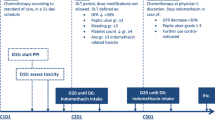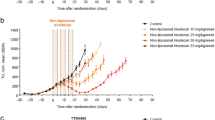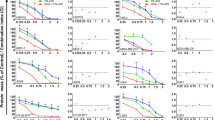Summary
Altered metabolism of cancer first highlighted by Otto Warburg has a long history. Although ignored for a considerable amount of time, it is now receiving substantial attention. We recently published results obtained with a combination of two drugs, lipoic acid and hydroxycitrate, targeting metabolic enzymes particularly affected in cancer: ATP citrate lyase and pyruvate dehydrogenase kinase. This treatment was as efficient as chemotherapy in the three mouse cancer models that were tested. In this work, we asked if our drug combination could be used in conjunction with standard cytotoxic chemotherapy, in particular cisplatin, to improve basic protocol efficacy. A combination of lipoic acid and hydroxycitrate was administered to mice implanted with syngeneic cancer cells, LL/2 lung carcinoma and MBT-2 bladder carcinoma, concommitantly with classical chemotherapy (cisplatin or methotrexate). We demonstrate that the triple combination lipoic acid + hydroxycitrate + cisplatin or methotrexate is more efficient than cisplatin or methotrexate used individually or the combination of lipoic acid and hydroxycitrate administered alone. Of particular note are the results obtained in the treatment of an 80 year-old female who presented with ductal adenocarcinoma of the pancreas accompanied by liver metastases. A treatment course using gemcitabine plus α-lipoic acid and hydroxycitrate gave highly promising results. The in vivo data, coupled with the case study results, suggest a possible advantage in using a treatment targeted at cancer metabolism in association with classical chemotherapy.




Similar content being viewed by others
References
Warburg O (1956) On the origin of cancer cells. Science 123:309–314
Vander Heiden MG, Cantley LC, Thompson CG (2009) Understanding the Warburg effect: the metabolic requirements of cell proliferation. Science 324:1029–1033. doi:10.1126/science.1160809
Gambhir SS, Czernin J, Schwimmer J, Silverman DHS, Coleman RE, Phelphs ME (2001) A tabulated summary of the FDG PET literature. J Nucl Med 42:1S–93S
Kroemer G, Pouyssegur J (2008) Tumor cell metabolism: cancer’s Achilles’ heel. Cancer Cell 13:472–482. doi:10.1016/j.ccr.2008.05.005
Gatenby RA, Gillies RJ (2004) Why do cancers have high aerobic glycolysis? Nat Rev Cancer 4:891–899. doi:10.1038/nrc1478
López-Lázaro M (2008) The warburg effect: why and how do cancer cells activate glycolysis in the presence of oxygen? Anticancer Agents Med Chem 8:305–312
Pederson PL (2007) Warburg, me and hexokinase 2: multiple discoveries of key molecular events underlying one of cancers’ most common phenotypes, the “Warburg effect”, i.e., elevated glycolysis in the presence of oxygen. J Bioenerg Biomembranes 39:211–222. doi:10.1007/s10863-007-9094-x
Mazurek S (2008) Pyruvate kinase type M2: a key regulator within the tumour metabolome and a tool for metabolic profiling of tumors. Ernst Schering Found Symp Proc 4:99–124
Dang CV (2007) The interplay between MYC and HIF in the Warburg effect. Ernest Schering Found Symp Proc 4:35–53
Hatzivassiliou G, Zhao F, Bauer D, Andreadis C, Shaw AN, Dhanak D, Hingorani SR, Tuveson DA, Thompson CB (2005) ATP citrate lyase inhibition can suppress tumor cell growth. Cancer Cell 8:311–321. doi:10.1016/j.ccr.2005.09.008
Bonnet S, Archer SL, Allalunis-Turner J, Haromy A, Beaulieu C, Thompson R, Lee CT, Lopaschuk GD, Puttagunta L, Bonnet S, Harry G, Hashimoto K et al (2007) A mitochondria-K+ channel axis is suppressed in cancer and its normalization promotes apoptosis and inhibits cancer growth. Cancer Cell 11:37–51. doi:10.1016/j.ccr.2006.10.020
Cao W, Yacoub S, Shiverick KT, Namiki K, Sakai Y, Porvasnik S, Urbanek C, Rosser CJ (2008) Dichloroacetate (DCA) sensitizes both wild-type and over expressing Bcl-2 prostate cancer cells in vitro to radiation. Prostate 68:1223–1231. doi:10.1002/pros.20788
Wong JY, Huggins GS, Debidda M, Munshi NC, De Vivo I (2008) Dichloroacetate induces apoptosis in endometrial cancer cells. Gynecol Oncol 109:394–402. doi:10.1016/j.ygyno.2008.01.038
Sun RC, Fadia M, Dahlstrom JE, Parish CR, Board PG, Blackburn AC (2010) Reversal of the glycolytic phenotype by dichloroacetate inhibits metastatic breast cancer cell growth in vitro and in vivo. Breast Cancer Res Treat 120:253–260. doi:10.1007/s10549-009-0435-9
Michelakis ED, Webster L, Mackey JR (2008) Dichloroacetate (DCA) as a potential metabolic-targeting therapy for cancer. Br J Cancer 99:989–994. doi:10.1038/sj.bjc.6604554
Michelakis ED, Sutendra G, Dromparis P, Webster L, Haromy A, Niven E, Maguire C, Gammer TL, Mackey JR, Fulton D, Abdulkarim B, McMurtry MS, Petruk KC (2010) Metabolic modulation of glioblastoma with dichloroacetate. Sci Transl Med 2:31ra34. doi:10.1126/scitranslmed.3000677
Tennant DA, Durán RV, Gottlieb E (2010) Targeting metabolic transformation for cancer therapy. Nat Rev Cancer 10:267–277. doi:10.1038/nrc2817
Schwartz L, Abolhassani M, Guais A, Sanders E, Steyaert JM, Campion F, Israël M (2010) A combination of alpha lipoic acid and calcium hydroxycitrate is efficient against mouse cancer models: preliminary results. Oncol Rep 23:1407–1416. doi:10.3892/or_00000778
Savage P, Stebbing J, Bower M, Crook T (2009) Why does cytotoxic chemotherapy cure only some cancers? Nat Clin Pract Oncol 6:43–52. doi:10.1038/ncponc1260
Tomayko MM, Reynolds CP (1989) Determination of subcutaneous tumor size in athymic (nude) mice. Cancer Chemother Pharmacol 24:148–154
Sonveaux P, Végran F, Schroeder T, Wergin MC, Verrax J, Rabbani ZN, De Saedeleer CJ, Kennedy KM, Diepart C, Jordan BF, Kelley MJ, Gallez B, Wahl ML, Feron O, Dewhirst MW (2008) Targeting lactate-fueled respiration selectively kills hypoxic tumor cells in mice. J Clin Invest 118:3930–3942. doi:10.1172/JCI36843
Wellen KE, Hatzivassiliou G, Sachdeva UM, Bui TV, Cross JR, Thompson CB (2009) ATP-citrate lyase links cellular metabolism to histone acetylation. Science 324:1076–1080. doi:10.1126/science.1164097
Padhye S, Ahmad A, Oswal N, Sarkar FH (2009) Emerging role of Garcinol, the antioxidant chalcone from Garcinia indica Choisy and its synthetic analogs. J Hematol Oncol 2:38
Akao Y, Nakagawa Y, Iinuma M, Nozawa Y (2008) Anti-cancer effects of xanthones from pericarps of mangosteen. Int J Mol Sci 9:355–370
Havelka AM, Berndtsson M, Olofsson MH, Shoshan MC, Linder S (2007) Mechanisms of action of DNA-damaging anticancer drugs in treatment of carcinomas: is acute apoptosis an “off-target” effect? Mini-Rev Med Chem 7:1035–1039
Jamieson ER, Lippard SJ (1999) Structure, recognition, and processing of cisplatin-DNA adducts. Chem Rev 99:2467–2498
Cepeda V, Fuertes MA, Castilla J, Alonso C, Quefedo C, Perez JM (2007) Biochemical mechanisms of cisplatin cytotoxicity. Anticancer Agents Med Chem 7:3–18
Cullen KJ, Yang Z, Schumaker L, Guo Z (2007) Mitochondria as a critical target of the chemotherapeutic agent cisplatin in head and neck cancer. J Bioenerg Biomembr 39:43–50. doi:10.1007/s10863-006-9059-5
Fisch MJ, Howard KL, Einhorn LH, Sledge GW (1996) Relationship between platinum-DNA adducts in leukocytes of patients with advanced germ cell cancer and survival. Clin Cancer Res 2:1063–1066
Volpato JP, Fossati E, Pelletier JN (2007) Increasing methotrexate resistance by combination of active-site mutations in human dihydrofolate reductase. J Mol Biol 373:599–611
Li JC, Kaminskas E (1984) Accumulation of DNA strand breaks and methotrexate cytoxicity. Proc Nat Acad Sci USA 81:5694–5698. doi:10.1016/j.jmb.2007.07.076
Celtikici B, Lawrance AK, Wi Q, Rozen R (2009) Methotrexate-induced apoptosis is enhanced by altered expression of methylenetrahydrofolate reductase. Anti-Cancer Drugs 20:787–793. doi:10.1097/CAD.0b013e32832f4aa8
Parmar MK, Ledermann JA, Colombo N, du Bois A, Delaloye JF, Kristensen GB, Wheeler S, Swart AM, Qian W, Torri V, Floriani I, Jayson G, Lamont A, Tropè C, ICON and AGO Collaborators (2003) Paclitaxel plus platinum-based chemotherapy versus conventional platinum-based chemotherapy in women with relapsed ovarian cancer: the ICON4/AGO-OVAR-2.2 trial. Lancet 36:2099–2106. doi:10.1016/S0140-6736(03)13718-X
Horwitz SB (1992) Mechanism of action of taxol. Trends Pharmacol Sci 13:134–136
Haldar S, Jena N, Croce CM (1995) Inactivation of Bcl-2 by phosphorylation. Proc Nat Acad Sci USA 92:4507–4511
Vermorken JB, Mesia R, Rivera F, Remenar E, Kawecki A, Rottey S, Erfan J, Zabolotnyy D, Kienzer H-R, Cupissol D, Peyrade F, Benasso M, Vynnychenko I, De Raucourt D, Bokemeyer C, Schuelere A, Amellal N, Hitt R (2008) Platinum-based chemotherapy plus cetuximab in head and neck cancer. N Engl J Med 359:1116–1127
Chou AJ, Geller DS, Gorlick R (2008) Therapy for osteosarcoma: where do we go from here? Pediatr Drugs 10:315–327
Ferrari S, Palmerini E (2007) Adjuvant and neoadjuvant combination chemotherapy for osteogenic sarcoma. Curr Opin Oncol 19:341–346. doi:10.1097/CCO.0b013e328122d73f
Van Dalen EC, de Camargo B (2009) Methotrexate for high-grade osteosarcoma in children and young adults. Cochrane Database Syst Rev 1:CD006325. doi:10.1002/14651858.CD006325.pub2
Teachey DT, Sheen C, Hall J, Ryan T, Brown VI, Fish J, Reid GSD, Seil AE, Norris R, Chang YJ, Carroll M, Grupp SA (2008) mTOR inhibitors are synergistic with methotrexate: an effective combination to treat acute lymphoblastic leukemia. Blood 112:2020–2023. doi:10.1182/blood-2008-02-137141
Casneuf FV, Demetter P, Boterbert T, Delrue L, Peeters M, Van Damme N (2009) Antiangiogenic versus cytotoxic therapeutic approaches in a mouse model of pancreatic cancer: an experimental study with a multitarget tyrosine kinase inhibitor (sunitib), gemcitabine and radiotherapy. Oncol Rep 22:105–113. doi:10.3892/or_00000412
Squadriano M, Fazio N (2010) Chemotherapy in pancreatic adenocarcinoma. Eur Rev Med Phamacol Sci 14:386–394
Jackson L, Evers BM (2006) Chronic inflammation and pathogenesis of GI and pancreatic cancers. Cancer Treat Res 130:39–65
Lipton A, Campbell-Baird C, Witters L, Harvey H, Ali S (2010) Phase II trial of gemcitabine, irinotecan, and celecoxib in patients with advanced pancreatic cancer. J Clin Gastroenterol 44:286–288. doi:10.1097/MCG.0b013e3181cda097
Brembeck FH, Schoppmeyer K, Leupold U, Gornistu C, Keim V, Mössner J, Riecken E-O, Rosewicz S (1998) A phase II pilot trial of 13-cis retinoic acid and interferon-α in patients with advanced pancreatic carcinoma. Cancer 83:2317–2323
Michael A, Hill M, Maraveyas A, Dalgleish A, Lofts F (2007) 13-cis-Retinoic acid in combination with gemcitabine in the treatment of locally advanced and metastatic pancreatic cancer–report of a pilot phase II study. Clin Oncol (R Coll Radiol) 19:150–153
Singh B, Murphy RF, Ding X-Z, Roginsky AB, Bell RH Jr, Adrian TE (2007) On the role of transforming growth factor-β in the growth inhibitory effects of retinoic acid in human pancreatic cancer cells. Mol Cancer 6:82. doi:10.1186/1476-4598-6-82
Dong Y-W, Wang X-P, Wu K (2009) Suppression of cancer growth by activating peroxisome proliferator-activated receptor γ involves angiogenesis inhibition. World J Gastroenterol 15:441–448. doi:10.3748/wjg.15.441
Li J, Orr B, White K, Belogortseva N, Niles R, Boskovic G, Dykes A, Park M (2009) Chmp 1A is a mediator of the anti-proliferative effects of all-trans retinoic acid in human pancreatic cancer cells. Mol Cancer 8:7. doi:10.1186/1476-4598-8-7
Ruiz-Rabelo JF, Vasquez R, Parea MD, Cruz A, Gonzalez R, Romero A, Munoz-Villanueva MC, Tunez I, Montilla P, Muntane J, Padillo FJ (2007) Beneficial properties of melatonin in an experimental model of pancreatic cancer. J Pineal Res 43:270–275. doi:10.1111/j.1600-079X.2007.00472.x
Fearon KC, Von Meyenfeldt MF, Moses AG, Van Geenen R, Roy A, Gouma DJ, Giacosa A, Van Gossum A, Bauer J, Barber MD, Aaronson NK, Voss AC, Tisdale MJ (2003) Effect of a protein and energy dense N-3 fatty acid enriched oral supplement on loss of weight and lean tissue in cancer cachexia: a randomised double blind trial. Gut 52:1479–1486
Berkson BM, Rubin DM, Berkson AJ (2009) Revisiting the ALA/N (alpha-lipoic acid/low dose naltrexone) protocol for people with metastatic and nonmetastatic pancreatic cancer: a report of 3 new cases. Integr Cancer Ther 8:416–422
Acknowledgments
We acknowledge the help of Jean-Marc Steyaert. This work was funded by Biorébus.
Written consent for publication was obtained from the patient.
Competing interests
METABLOC is a trade mark of Biorébus.
AG is an employee of Biorébus. The other authors declare that they have no competing interests.
Author information
Authors and Affiliations
Corresponding author
Additional information
Guais Adeline and Baronzio Gianfranco contributed equally to the article
Electronic supplementary material
Supplemental tables number 1a, 1b, 2a, 2b, 3a and 3b describing the statistical results in details.
Supplementary Table 1
(DOC 39 kb)
Supplementary Table 2
(DOC 33 kb)
Supplementary Table 3
(DOC 33 kb)
Rights and permissions
About this article
Cite this article
Guais, A., Baronzio, G., Sanders, E. et al. Adding a combination of hydroxycitrate and lipoic acid (METABLOC™) to chemotherapy improves effectiveness against tumor development: experimental results and case report. Invest New Drugs 30, 200–211 (2012). https://doi.org/10.1007/s10637-010-9552-x
Received:
Accepted:
Published:
Issue Date:
DOI: https://doi.org/10.1007/s10637-010-9552-x




